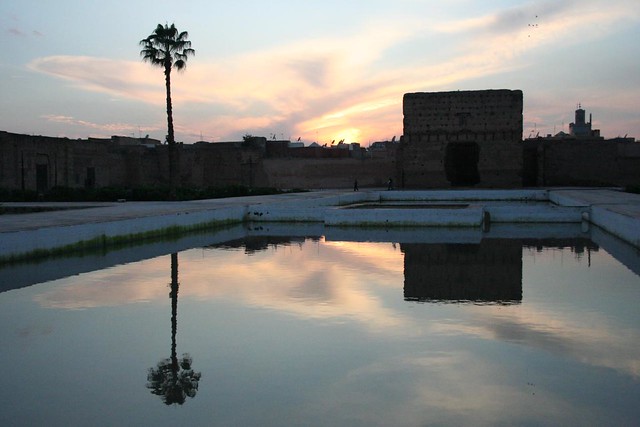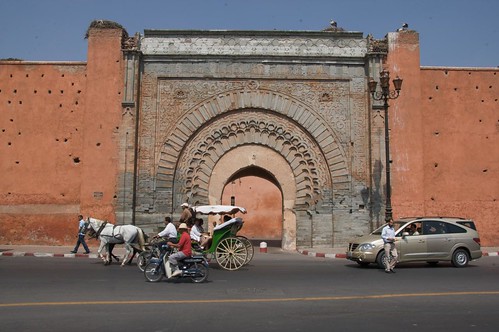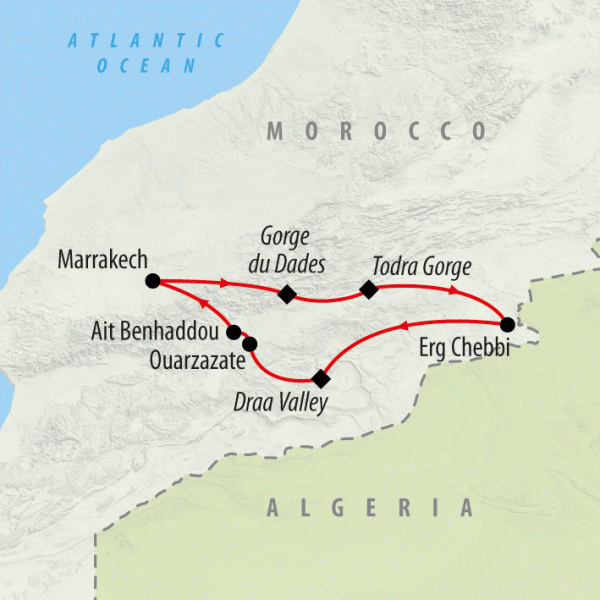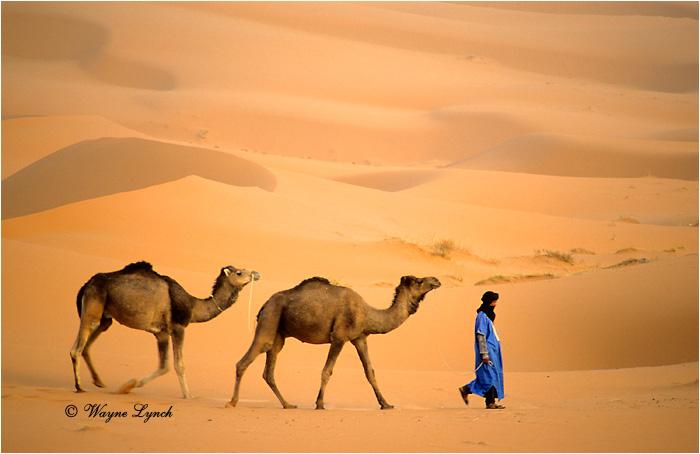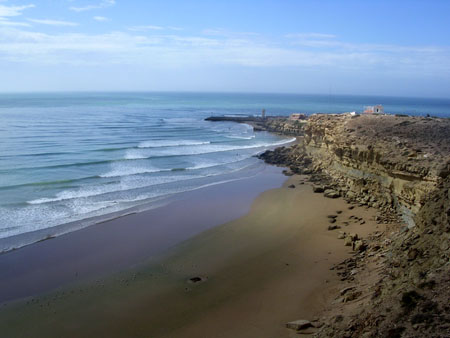History of Marrakech, Morocco
Marrakech area was inhabited by Berber farmers of the Neolithic, and many stone tools were found in the area.Marrakech was founded in 1062 (454 in the Hijri calendar) by Abu Bakr ibn Umar, chief and cousin Yusuf ibn Tachfin. Led by the Almoravids, pious warriors and scholars from the desert, many mosques and madrasas (Islamic schools) were built, the community development in a mall for the Maghreb and sub-Saharan Africa has increased Africa.Marrakech and quickly established himself as a cultural and religious center, supplanting Aghmat which has long been the capital of Haouz. Palaces were built and decorated by craftsmen Andalusian Cordoba and Seville, developing the Umayyad style that was characterized by sculpted domes and cusped arches.This Andalusian influence merged with patterns of West Africa and Sahara, creating a unique style of architecture that was totally adapted to the environment Marrakesh. Yusuf ibn Tachfin completed mosque, built houses, coins minted and brought gold and silver to the city in caravans. The city became the capital of the Almoravid Emirate, which stretches along the shores of Senegal to central Spain and the Atlantic coast in Algiers.
The city was then fortified by the son of Tachfin, Ali ibn Yusuf, who built the ramparts 1122-1123 which remain to this day, supplemented by other mosques and palaces and developed a groundwater system in the city known rhettara to irrigate his new garden. In 1125, the preacher Ibn Tumert moved to Tin Mal in the mountains south of Marrakech. He preached against the Almoravids and managed to influence a revolt that led to the fall of Aghmat close, but unsuccessful siege in 1130 in Marrakesh, to capture the city.
In 1147, the Almohads, who married orthodox Islam and derives Masmouda tribes of the High Atlas, the city takes in chief Abd el-Mumen.After a long siege and the massacre of some 7,000 people, the last of the Almoravids were exterminated in Apart from those who sought exile in the Balearic Islands. As a result, almost all the monuments were built destroyed.The Almohades a range of palaces and religious buildings, such as the famous mosque of Koutoubia between 1184 and 1199, built on the ruins of a palace Almoravid. He was a twin of the Giralda of Seville and the (non) Hassan Tower in Rabat, all built by the same designer. Kasbah houses the residence caliphate (from the reign of Abd al-Mumin the Almohad ruler bore the title of caliph, rivaling the far east of the Abbasid Caliphate). The Kasbah was named after Caliph Abu Yusuf Yaqub al-Mansur. To irrigate palm groves and parks, including the new Menara garden, the irrigation system has been developed Because of its cultural reputation, Marrakech has attracted many writers and artists, including Andalusia including the famous philosopher Averroes of Cordoba, known for his commentaries on Aristotle. In 1269, Marrakech was conquered by nomadic tribes who invaded Zenata the last Almohads.The city then fell into a state of lethargy. Its decline has quickly led to the loss of its status as capital was abandoned to his great rival, Fez.
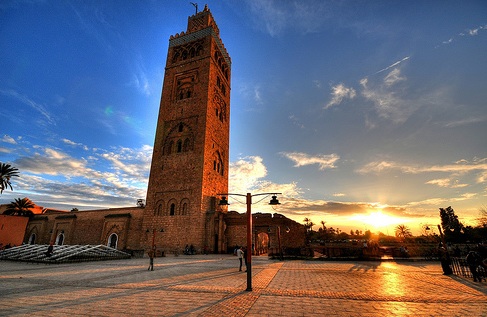
View of Marrakesh and El Badi Palace, by Adriaen Matham, 1640.
In the early sixteenth century, Marrakech again became the capital of the kingdom, after a period when it was the seat of the emirs Hintata. It is quickly restored its status, particularly during the reigns of sultans Saadi Abu Abdallah al-Qaim and Ahmad al-Mansur. Thank you to the wealth amassed by the Sultans, Marrakech was embellished with sumptuous palaces, while its ruined monuments have been restored. El Badi Palace, built by Ahmad al-Mansur in 1578, was a replica of the Alhambra Palace, made with the most precious materials from Italy (marble), Sudan (gold dust), India (porphyry) and even China (jade). The palace was intended primarily for lavish receptions to welcome the ambassadors of Spain, England and the Ottoman Empire, featuring Saadian Morocco as a country whose power and influence extended to the borders of Mali.Under Niger and the Saadian dynasty, Marrakesh has regained its former position as a focal point for the caravan routes from North Africa, the Mediterranean and sub-Saharan Africa. As a center of commerce, Marrakech once influenced the political polarization of the western Maghreb. The Portuguese had established trading posts in many Muslim cities in the south, including Azemmour Safi in 1486 and, in 1488, and others later.
For centuries Marrakech has been known for its "seven saints." When sufism was at the height of its popularity, during the reign of Moulay Ismail, the festival of the saints was founded by Abu Ali al-Hassan al- Yusi at the request of the sultan. tombs of several renowned figures were moved to Marrakech to attract pilgrims in the same way Essaouira did at that time with its festivals Regrega. The seven saints (sebaatou rizjel) is now a firmly established institution . the saints include Sidi Bel Abbas (the patron saint of the city), Sidi Muhammad al-Jazouli, Sidi Abu al-Qasim Al-Suhayli, Cadi Ayyad ben Moussa, Abdelaziz al-Abdullah al-Tebaa and Ghazwani.
Left: Marrakech in 1919. Right: You hami El Glaoui (1879-1956), Pasha of Marrakech
Until 1867, individual Europeans were not allowed to enter the city, unless they have acquired special permission from the Sultan. During the early 20th century, Marrakech suffered several years of unrest. After the death in 1900 of grand vizier Ba Ahmed, real regent of the empire until Abd al-Aziz Morocco became of age, the country fell into the throes of anarchy, rebellion and tribal plots of feudal lords, not to mention European intrigues. In 1907, Moulay Abd al-Hafid, Caliph (Representative of Makhzen) of Marrakech, was proclaimed sultan by the powerful tribes of the High Atlas and researchers Ulama, who denied the legitimacy of his brother Abd al-Aziz. [18] It was also in 1907 that Dr. Mauchamp, a French doctor, was murdered in Marrakech, suspected of spying for his country.France used the event as an excuse to send troops to Morocco Oujda, in east of Casablanca, in the west. The French colonial army, however, met with strong resistance Ahmed al-Hiba, a son of the great Sheikh Ma el-Aynayn, who came with his warriors Saharan nomadic tribes Reguibat. On 30 March 1912, the French protectorate in Morocco was established.After the Battle of Sidi Bou Othman, which saw the victory of the forces on column Mangin al-Hiba in September 1912, the French seized Marrakech. The conquest was facilitated by rallying Imzwarn tribes and their leaders of the powerful Glaoui family and a massacre took place here during the crisis.
A Imzwarn, Te hami El Glaoui, known as "Lord of the Atlas" became Pasha of Marrakech, a position he held for almost the entire 44 years of the Protectorate. Glaoui dominates the city, and became famous for its collaboration with the authorities of general residence, resulting in a plot to dethrone Mohammed Ben Youssef (Mohammed V) to replace the Sultan's cousin, Ben Arafa Thami El Glaoui, already known for his love affairs and lavish lifestyle, has become an important symbol of the colonial Morocco. He could not, however, submit the rise of nationalist sentiment or hostility of an increasing share of the population. He could not resist the pressure from France, which has agreed to end its protectorate of Morocco because of the dire situation in Indochina and the beginning of the war in Algeria. After two successive exiles (Corsica and Madagascar), Mohammed Ben Youssef was allowed to return to Morocco in November 1955, ending the despotic rule of the Glaoui of Marrakech and the surrounding area.
A resting place for a caravan? A staging area for troops? A sultan’s paradise? A religious center or modern city? What is Marrakech? Actually, the city has been all the above. From humble Berber beginnings as an oasis, this city has become vibrant international destination while keeping its ancient Islamic roots.
Marrakesh (or Marrakech), sometimes called the red town because of the red Kasbah wall surrounding the medina, was founded in 1062. Youssef bin Tashufin, cousin to the sultan began construction of the city. Under his watch, houses were built and a mosque begun. Marrakech was the capital of the Almoravid Empire that covered a vast area from Maghreb to Europe. Now, along with the Berber, the Andalusia influence was born.
Marrakech, under the Almoravid grew into an important splendid Islamic city of commercial power and wealth.
Captured by the Almohads in 1147, the religious and civil buildings were torn down. Abdal Mou’min, the great builder, began the Koutoubia mosque. This mosque and its spectacular minaret gave Marrakech its most outstanding landmark. Other important structures such as Menara Gardens were also built in this time frame. Scholars, philosophers and other thinkers of the time converged on the city. Caravans came through ancient Marrakech, making it a very powerful commercial center.
Taken over by the Merenids in the mid-1200s started Marrakesh on a downward spiral. Fez had already been established as the capital. Caravans stopped coming and the major source of income was lost. Marrakech was neglected by the Merenids and fell into a period of decline.
Saadians took over Morocco in 1522. Mostly in ruins, the leader chose to make Marrakech his capital in 1551. Under the guidance of Mohammed Al Mahdi, Marrakech began to be restored to its former grandeur. During this period, the Saadians built many wonderful structures such as the Al Bedi Palace. A glimpse into the life of Sultan can be seen in this still beautiful place. Moroccan crafts reached a pinnacle under this dynasty attracting many artisans whose work is still visible today. Additionally, Marrakech drew Islamic holy men to its gates. Upon death, many were buried within the city’s splendid tombs. By the 1600s, Marrakech had been restored to its former glory. Remaining culturally and economically important until the 1669, it had become the most important and influential city in all of Morocco.
An invasion and capture by the Alaouites in 1669 saw Marrakech lose its status, again. The Alaouite sultan moved the capital back to Fez. Marrakech fell into disrepair one more time.
Mid 1700s saw Mohammed III restore most of Marrakech. It remained largely unchanged until 1917. The French invaded Morocco and routed the Saharan chieftain, El Hiba who had captured Marrakech in 1912. Morocco was held as a protectorate by France and was governed by the Pasha El Glaoua. The French assisted with revolts of the Berber tribes. Under French tutelage, the Pasha became one of the richest, most influential men in Morocco. A French-styled city was begun outside the medina walls in 1913. French protection ended in the mid 20th century.
Morocco gained her independence from France in 1956. The new king, Mohammed V took over the throne and the Glaoua family was removed from power and its wealth confiscated. With the new monarchy, the capital was moved to Rabat.

Marrakech, today, is an important provincial city. Its Islamic roots are displayed proudly. French occupation brought in European influence, as the new city of Marrakech shows. However, the heart of Marrakech, still beats to the same ancient rhythm.
As history beckons the Morocco came into the Neolithic age during 8000 BC. It was the Capsian culture that initiated Morocco into the Neolithic age. It was the time when Magreb was less dry than the present day situations. This suggests that the history of Morocco is very old and very rich. The cultural development in the country was strongly followed into the cities as well, making them well developed from the early stages of the history. History of Marrakech narrates the glorified past of the city which is as old as agriculture to the Moroccans.
The Moroccan culture is considered to be one of the oldest in Asia. The first language to arrive was Berber which probably arrived with agriculture. The DNA analysis of the Moroccans suggests that the population has great influence of different population from various parts of the world including the local ethnic groups.
Marrakech was founded in the 11th century and was once the proud capital of a massive empire that ran through the present day Africa to Europe. The empire covered an area from Spain to Senegal. From an early age Marrakech had been a key destination for business purpose a sit laid on the crossroads of ancient caravan routes from Timbuktu. It was the supply chain route for precious materials like gold, salt and slaves bound for Europe for the sub-Saharan traders.
The present day Marrakech is the link between Africa and Europe. It is not just trade which makes Marrakech so important, but the place is also the connecting link for culture between the two continents.
The rich heritage of Marrakech includes the ravishing snow-capped Atlas Mountains, age old palm groves, faded red ochre walls and the enchanting Arabian music that casts a magical spell in the mind of the travelers.
The history of Marrakech also upholds the brilliant architecture of the buildings and monuments of the city.
morocco culture,moroccan food,morocco food,moroccan cuisine,morocco beaches,moroccan meal,beaches in morocco,moroccan culture,hercules cave,hercules cave morocco


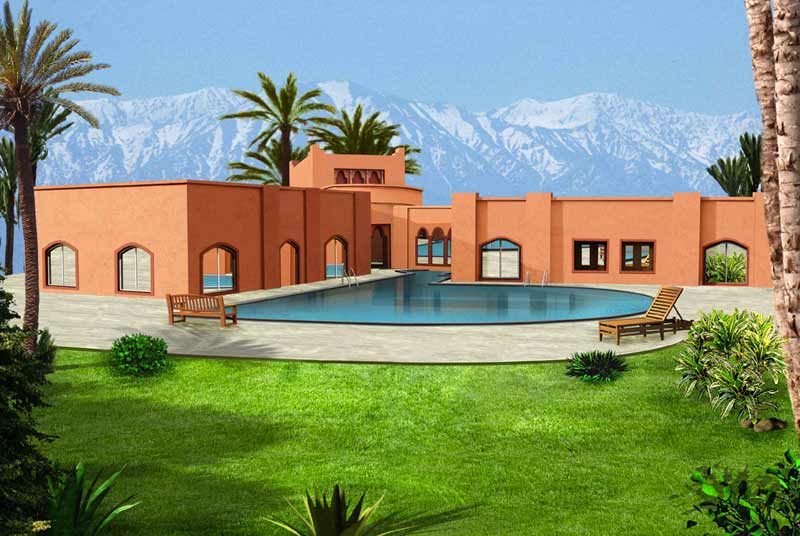


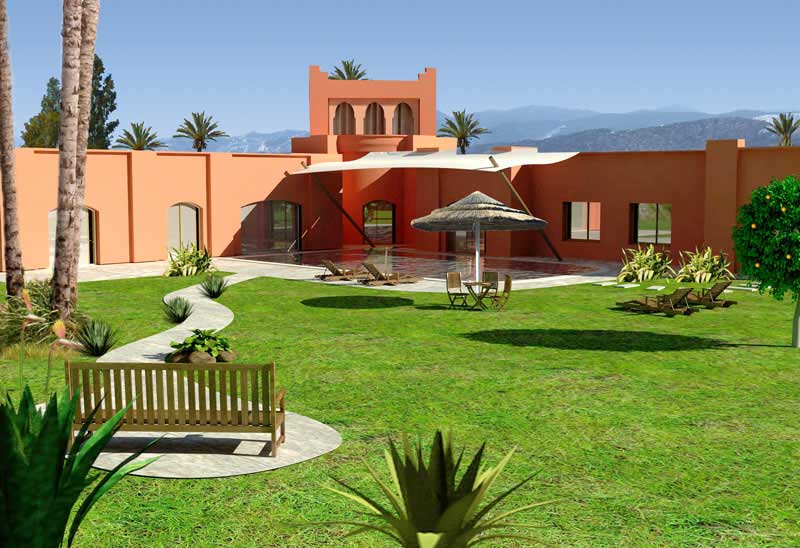








 morocco culture,moroccan food,morocco food,moroccan cuisine,morocco beaches,moroccan meal,beaches in morocco,moroccan culture,hercules cave,hercules cave morocco
morocco culture,moroccan food,morocco food,moroccan cuisine,morocco beaches,moroccan meal,beaches in morocco,moroccan culture,hercules cave,hercules cave morocco








